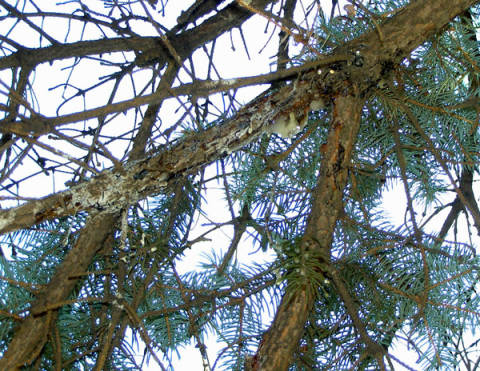Quick facts
- Cytospora canker is a common disease on spruce trees that are stressed by drought, winter injury or other factors.
- Cankers kill random branches throughout the tree canopy.
- Cytospora rarely kills spruce trees, but can badly deform them and damage the look of the tree.
- Prune out and destroy infected branches during dry weather.
- Plant Norway or white spruce instead of Colorado blue spruce.
How to identify Cytospora canker
- Cytospora canker is most common on Colorado blue spruce but can affect all spruce trees grown in Minnesota.
- The disease is common on large mature trees.
- Dead or dying branches are scattered throughout the tree.
- On dying branches, needles turn brown or purplish-brown, then fall off.
- Cankers are located close to the trunk of the tree on dead or dying branches.
- A thick layer of hard, dry, bluish-white resin will coat the area of the branch over the canker.
- This resin is often dried in the form of drips and bumps.
How does Cytospora survive and spread?
Cytospora canker is caused by the fungus Leucostoma kunzei. This fungus is often present in healthy branches. Disease begins when the tree becomes stressed by insect feeding, snow or ice damage, drought or other factors.
A sunken canker forms on branches and is often coated in a thick layer of resin. It may take several years for the canker to girdle the branch.
Once girdled, the branch dies and the needles turn brown and fall off. The fungus quickly grows throughout the dead branch, but rarely grows into the tree trunk. The tree trunk can be infected through wounds.
Dark, raised, pimple-like, spore-producing structures form on infected branches. These structures release yellow tendrils of spores in wet weather. Spores are spread to new branches by wind or rain.
Cytospora canker rarely kills spruce trees, but it can severely deform them. Trees that have lost many branches to Cytospora canker are unattractive, do not provide privacy screening, or block sound or unsightly views. These trees are often removed and replaced.
How to manage Cytospora canker in spruce trees
- Plant spruce trees on sites with moist, well-drained soil in full sun. Spruce trees grow well under these conditions and will have reduced stress as a result.
- Plant Norway or white spruce instead of Colorado blue spruce. Colorado blue spruce are not native to Minnesota and are stressed by the growing conditions. Norway and white spruce are better adapted to Minnesota.
- Reduce stress on spruce trees by providing water during periods of drought.
- Mulch the soil beneath the tree.
- Check spruce trees once a year for cankers.
- Prune out and destroy infected branches during dry weather. It may take two consecutive seasons of pruning to significantly reduce the disease.
Reviewed in 2024



